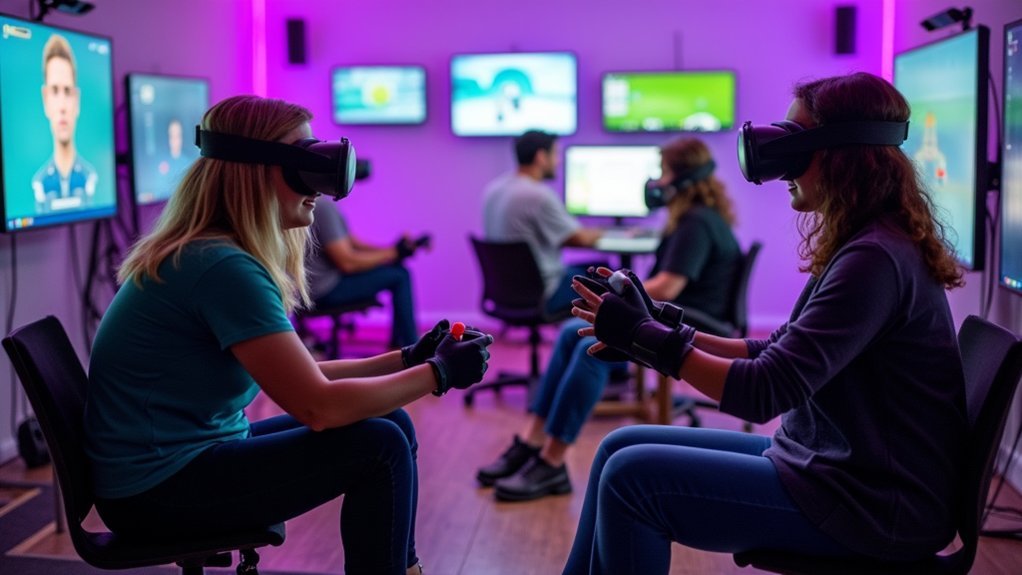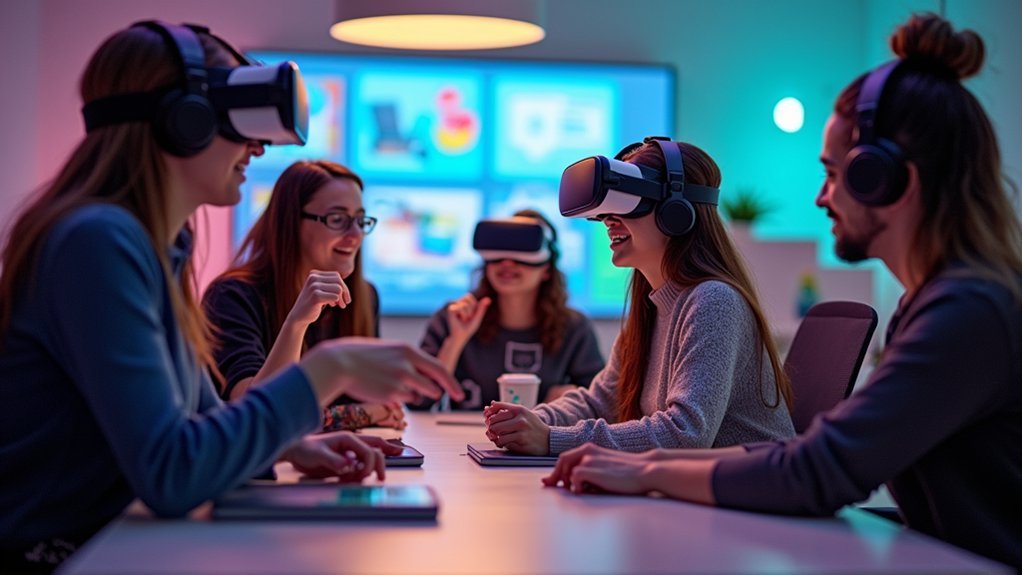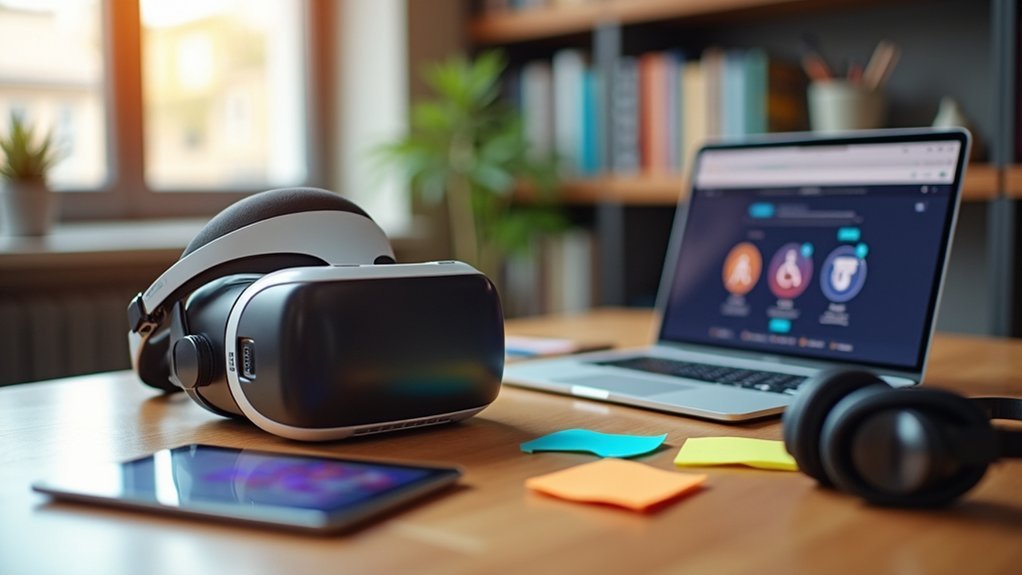You’ll create more accessible VR tutorials by implementing multiple input methods like adaptive controllers and voice commands, designing high-contrast visual cues with audio prompts for navigation, and offering customizable text sizes with thorough captioning. Include panic buttons and safe spaces for user comfort, maintain 90+ fps to reduce motion sickness, and integrate speech recognition technology. Test regularly with diverse user groups to guarantee effectiveness. These foundational strategies will transform your tutorials into truly inclusive learning experiences.
Implement Multiple Input Methods for Diverse Physical Abilities

While traditional VR setups rely heavily on handheld controllers, you’ll need to expand beyond these limitations to create truly accessible tutorials. Implementing multiple input methods guarantees users with varying physical abilities can interact effectively with your VR environment.
Consider integrating adaptive controllers, voice commands, gesture-based controls, and hand tracking as core accessibility options. Support Bluetooth keyboards for users with fine motor impairments who struggle with traditional controllers.
Multiple input methods including adaptive controllers, voice commands, and hand tracking ensure VR tutorials remain accessible to users with diverse physical abilities.
Enable customizable control remapping so users can configure specific setups that accommodate their physical capabilities. Integrate tools like WalkinVR Driver to help users with mobility challenges navigate virtual spaces using adaptive movements.
Include voice-to-text features that allow individuals to provide input without manual typing, streamlining communication and interaction throughout your tutorial experience.
Design Clear Visual and Audio Cues for Navigation
After establishing robust input alternatives, you must focus on creating navigation systems that work seamlessly across all sensory modalities.
Your visual cues should use high-contrast colors and clear symbols that remain distinguishable for users with varying visual abilities. Design arrows and highlighted pathways to indicate movement direction and interaction points throughout complex scenes.
Complement these with audio cues like directional sounds and voice prompts that guide users with visual impairments through your experience.
You’ll need robust accessibility settings allowing users to customize visual cue sizes, colors, and audio volume levels to match their individual needs.
Regular testing with diverse user groups, including those with disabilities, guarantees your navigation system effectively guides everyone through your VR tutorial experience.
Customize Text Display Options for Enhanced Readability

Since users experience text differently based on their visual abilities and reading preferences, you must implement extensive text customization options that accommodate diverse needs.
Customizing text display options creates an inclusive VR environment where every learner can access content comfortably. Adjustable text sizes help users with low vision read instructions clearly, while proper color contrast guarantees legibility for those with visual impairments or color blindness.
Essential text customization features include:
- Font Selection and Sizing – Offer multiple font types and size adjustments to support users with dyslexia and varying visual acuities.
- Display Mode Options – Provide light and dark themes to reduce eye strain and accommodate personal preferences.
- Color Customization – Enable users to modify text and background colors for ideal contrast and personalized viewing experiences.
These adaptations transform your VR tutorial into an accessible learning platform.
Provide Comprehensive Captioning for All Audio Content
Building on visual accessibility improvements, audio content requires equally thoughtful consideration to create truly inclusive VR tutorials.
You’ll need thorough captioning that covers all spoken dialogue, music, and sound effects to support users with hearing impairments. When speakers aren’t visually apparent, identify them clearly in your captions. Include descriptive elements like music mood and song lyrics to enrich the experience through visual text.
Don’t forget to caption periods of silence, preventing confusion about whether audio content continues. Your captions should note when no dialogue occurs.
Implement customizable captioning options allowing users to adjust text size, font, and color contrast based on their visual preferences. These features guarantee every learner can access your tutorial’s audio information effectively.
Offer Alternative Communication Channels for User Interaction

How can you assure every user feels confident participating in your VR tutorial, regardless of their communication abilities?
You’ll need to implement alternative communication channels that accommodate diverse accessibility needs within your immersive technology environment.
Create multiple pathways for users to interact effectively:
- Voice and Text Integration – Combine speech-to-text functionality with onscreen chat boxes, allowing users to communicate through their preferred method.
- Visual Communication Systems – Include non-verbal prompts and visual cues for users who struggle with audio-based interactions.
- Tactile Feedback Networks – Integrate haptic feedback to provide physical communication cues, especially benefiting deaf or hard-of-hearing participants.
Additionally, you should enable customizable notification settings so users can adjust how they receive communication alerts.
Empower users with personalized notification controls that adapt communication delivery methods to match individual accessibility preferences and comfort levels.
These alternative communication channels assure your VR tutorial remains inclusive and accessible to all participants.
Create Adjustable Difficulty Levels for Progressive Learning
You’ll create more effective VR tutorials when you scaffold learning complexity through carefully structured difficulty progressions that build foundational skills before introducing advanced concepts.
By implementing adaptive skill pathways, you can guarantee learners master core competencies at each level while providing personalized routes that respond to individual performance and learning preferences.
This approach prevents cognitive overload and maintains engagement by matching tutorial challenges to each user’s current abilities and growth trajectory.
Scaffold Learning Complexity
When learners encounter complex VR tutorials without proper progression, they often become overwhelmed and abandon the experience entirely. You must scaffold learning complexity by designing training experiences that break complex tasks into digestible steps.
Start with fundamental concepts before advancing to challenging operations.
Effective scaffolding in immersive learning environments requires strategic implementation:
- Gradual skill building – Begin with basic interactions like object selection, then progress to multi-step procedures that combine previously learned skills.
- Adaptive assessments – Monitor user performance continuously and adjust difficulty based on their demonstrated competence, ensuring ideal challenge levels.
- Dynamic support systems – Provide visual cues and hints during complex operations, gradually reducing assistance as users develop proficiency and confidence in the virtual environment.
Adaptive Skill Pathways
Since learners bring vastly different skill levels and learning speeds to VR tutorials, you need adaptive skill pathways that automatically adjust difficulty based on individual performance.
These pathways create adjustable difficulty levels that respond to user capabilities, ensuring everyone receives appropriate challenges without becoming overwhelmed or bored.
You’ll want to implement branching scenarios that let learners make choices affecting their progression.
This accommodates varying abilities while promoting essential thinking skills.
Real-time feedback becomes vital here—it helps users understand their progress and adjust their approach accordingly.
Establish Safe Spaces and Pause Functions for Overwhelmed Users
You’ll need instant exit options that let users escape overwhelming situations with a single button press or gesture.
Creating calming virtual environments—like serene gardens or quiet rooms—gives users a mental reset when the main tutorial becomes too intense.
Quick recovery features should restore users to their last comfortable progress point, ensuring they don’t lose achievements while managing their stress levels.
Instant Exit Options
Although VR tutorials can provide immersive learning experiences, they can also trigger anxiety, motion sickness, or sensory overload that makes users feel trapped within the virtual environment.
Implementing instant exit options guarantees every accessibility user can quickly escape overwhelming situations and regain control.
Your instant exit system should include:
- Prominent panic button – Position a clearly labeled emergency exit button that’s always visible and easily reachable, using bright colors or distinctive shapes that stand out from other interface elements.
- Multiple activation methods – Provide various ways to trigger exits, including voice commands, gesture controls, or hardware buttons to accommodate different user abilities and preferences.
- Immediate response time – Confirm your instant exit options respond within milliseconds, preventing users from feeling stuck or helpless during distressing moments in the virtual environment.
Calming Virtual Environments
When users feel overwhelmed in VR tutorials, they need immediate access to calming virtual environments that serve as psychological refuges within the digital space.
Design serene settings featuring nature scenes or minimalist layouts to create soothing atmospheres. You’ll want to include pause functions that give users complete control over their experience, preventing sensory overload when stress levels rise.
Establish clear visual markers for safe zones where users can retreat during overwhelming moments. These designated areas should feel distinctly separate from tutorial content.
Implement gradual shifts and gentle animations to ease cognitive load as users navigate between sections.
Prioritize accessibility by consistently gathering user feedback about your calming features. This input helps you refine environments to meet diverse needs and guarantees your virtual spaces truly support all learners effectively.
Quick Recovery Features
Three essential quick recovery features form the foundation of accessible VR tutorials: instant pause controls, dedicated safe spaces, and emergency exit options.
These quick recovery features let you regain composure when feeling overwhelmed, ensuring you maintain control throughout your experience.
Effective implementation requires strategic visual cues that guide you to recovery options. Icons and prompts make these features immediately recognizable, especially benefiting users with cognitive impairments who need clear navigation pathways.
Consider these implementation strategies:
- Place pause buttons prominently within your field of view for instant accessibility.
- Design safe spaces as calming virtual environments separate from tutorial content.
- Provide regular tutorials demonstrating how to access these accessible recovery options.
User feedback consistently shows that having reliable recovery features creates longer, more enjoyable VR engagements while reducing anxiety.
Optimize Frame Rates and Reduce Motion Sickness Triggers
While technical specifications might seem secondary to content creation, optimizing frame rates stands as one of the most critical factors in preventing motion sickness during VR tutorials. You’ll want to maintain 90 frames per second or higher to synchronize head motion with virtual displays, greatly reducing discomfort.
For immersive tutorials, implement smooth locomotion rather than abrupt movements, though you should provide teleportation options for motion-sensitive users.
Enhance user comfort by incorporating fade effects during scene changes in 360° content to prevent sudden visual alterations. Consider recommending airflow solutions like fans to complement visual experiences with physical sensations.
Start tutorials with shorter sessions, allowing users to gradually build VR tolerance. These technical optimizations guarantee your educational content remains accessible while maintaining the immersive qualities that make VR tutorials effective.
Integrate Voice Commands and Speech Recognition Technology
Voice commands transform VR tutorials from complex hand-gesture experiences into intuitive, speech-driven interactions that welcome users of all abilities.
Voice commands break down VR barriers, turning complex gestures into simple speech that empowers every user to learn effortlessly.
When you integrate speech recognition technology, you’re creating pathways for hands-free navigation that specifically benefit users with physical disabilities while enhancing accessibility for everyone.
Your implementation strategy should focus on these key areas:
- Customizable sensitivity settings – Allow users to adjust voice recognition responsiveness based on their speaking patterns and environmental conditions.
- Visual impairment guidance – Implement voice prompts that narrate tutorial steps and provide spatial orientation cues.
- Alternative text input methods – Convert spoken words directly into text, eliminating barriers for users who struggle with traditional typing interfaces.
These voice commands create inclusive virtual environments where accessibility becomes the foundation for universal usability.
Test With Real Users Across Different Accessibility Needs
How can you guarantee your VR tutorial truly serves users with diverse accessibility needs? You must test with real users who’ve varying disabilities and accessibility requirements. Theoretical assessments can’t replace authentic user experiences that reveal hidden challenges.
Recruit participants with different physical abilities, cognitive skills, and sensory impairments to evaluate your VR tutorials. Watch how they interact with speech-to-text features, customizable input options, and navigation systems.
You’ll discover specific pain points like confusing menu layouts or unclear instructions that you’d never identify otherwise.
This collaborative approach transforms your development process. Each testing session provides insights that lead to targeted improvements, ensuring your tutorials genuinely accommodate diverse learners rather than simply checking accessibility boxes.
Frequently Asked Questions
How to Create a VR Training?
Start by defining your virtual environment with clear onboarding processes. Develop modular content incorporating safety procedures and virtual hazards. Implement customizable accessibility features, multiple input options, and integrate with existing Learning Management Systems for seamless progress tracking.
How to Make Training More Accessible?
You’ll make training more accessible by offering multiple input methods, adjustable text settings, thorough audio support, clear onboarding instructions, and multilingual content that accommodates diverse physical, visual, auditory, and cognitive needs.
What Are the Accessibility Issues With VR?
You’ll face motion control barriers for users with dexterity issues, sensory overload affecting cognitive function, complex interfaces hindering navigation, flashing content triggering seizures, and inadequate audio alternatives excluding deaf users.
How to Make Online Learning Accessible?
You’ll create accessible online learning by implementing adjustable text options, adding captions for audio content, providing multiple communication methods, incorporating text-to-speech functionality, and offering alternative input methods like voice commands.





Leave a Reply